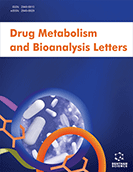Abstract
Objective: This work describes a simplified, 96-well plate method for determining the blood-to-plasma concentration ratio (BP ratio) for small molecules.
Methods: The need for calibration curves was eliminated using a matrix-matching approach in which blood samples were mixed with blank plasma and plasma samples were mixed with blank blood. As a result, both blood- and plasma-origin samples shared an equivalent matrix ahead of bioanalysis. In the in vitro assay, identical sample matrices were achieved by using the same source of blank plasma and blood.
Results: In humans, a good correlation (R2 = 0.84) was observed between the data obtained in this matrix-matching method and literature values for 11 commercial compounds possessing a wide range of logD values across multiple chemical classes. In addition, this method showed good agreement with in vitro BP ratios for 10 proprietary compounds determined radiometrically (R2 = 0.72) in human and preclinical species. Finally, the in vitro matrix matching method compared favorably to BP ratios determined ex vivo for 13 proprietary and literature compounds (R2 = 0.87) in rat.
Conclusion: This method, suitable for in vitro and ex vivo BP ratio determinations, is operationally efficient, robust, and a useful improvement upon previously published methods.
Keywords: Blood-to-plasma ratio, blood cell partitioning, pharmacokinetics, blood distribution, bioanalysis, radiometrically, blank plasma.
[PMID: 25836959]
[http://dx.doi.org/10.4155/bio-2019-0019] [PMID: 30973016]
[http://dx.doi.org/10.1016/S0379-0738(02)00023-3] [PMID: 11955826]
[http://dx.doi.org/10.1016/S0378-4347(00)86110-1] [PMID: 6841533]
[http://dx.doi.org/10.1097/00007691-200408000-00007] [PMID: 15257067]
[http://dx.doi.org/10.1248/bpb.31.1215] [PMID: 18520057]
[http://dx.doi.org/10.1021/js960026h] [PMID: 8773950]
[http://dx.doi.org/10.1002/rcm.1777] [PMID: 15609367]
[http://dx.doi.org/10.1002/jps.22709] [PMID: 21780122]
[http://dx.doi.org/10.1002/bdd.2265] [PMID: 33625733]
[http://dx.doi.org/10.1124/jpet.111.187112] [PMID: 22190645]
[PMID: 9311024]
[http://dx.doi.org/10.1016/0009-9236(95)90223-6] [PMID: 7781260]
[http://dx.doi.org/10.1002/cpt1977225part1557] [PMID: 913023]
[http://dx.doi.org/10.1111/j.1365-2125.1981.tb01263.x] [PMID: 7295488]
[http://dx.doi.org/10.1016/j.ejps.2008.12.011] [PMID: 19152835]
[http://dx.doi.org/10.1111/j.2042-7158.1993.tb03676.x] [PMID: 8094444]
[PMID: 1503601]































